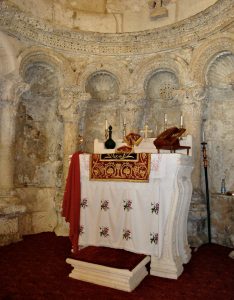Tur Abdin’s original bishopric
Old name: Hah (Suryani)
 For visitors to the Tur Abdin near Midyat one of the best starting points for exploration has to be Anıtlı, today a remote village in the middle of nowhere but until 613 the seat of the region’s first bishopric, as it was again between the 11th and 13th centuries.
For visitors to the Tur Abdin near Midyat one of the best starting points for exploration has to be Anıtlı, today a remote village in the middle of nowhere but until 613 the seat of the region’s first bishopric, as it was again between the 11th and 13th centuries.
Here the Church of the Virgin Mary (Meryemana) probably dates back to the sixth century and comes crowned with an extraordinary two-storey square structure covered in blind arcading. Interestingly, the upper storey was only built ito replace an older dome n the 20th century, which is when the belltower was also added.
The church is surrounded by a wall that encloses a courtyard and an arched structere known as a beth slutho (house of prayer) where services are held in high summer to avoid the sweltering heat of the relatively small and windowless interior. There, a small apse opens onto a nave designed to let two choirs sing in harmony.
The nave itself is elongated from north to south rather than from east to west as in a more familiar Catholic or Protestant church. The elaborate carvings on the arches supporting the dome are a reminder of the church’s past importance.
Why was the bishopric based in a such a remote location?
Local legend offers an alternative to the story of the Three Kings told in the Bible. In this version Twelve Kings set off to follow the star that was said to indicate the birthplace of a newborn king (Jesus). They arrived first at Hah whence only three of them continued to Jerusalem. There they were given one of Jesus’ swaddling bands in return for their gifts of gold, frankincense and myrrh. Back in Hah, the plan was to burn it so that the ashes could be divided between the twelve kings. Instead, the fire converted the swaddling band into twelve gold medallions whereupon the kings laid the foundations for the church in memory of this miracle .
Although the main reason to come to Anıtlı has to be a visit to St. Mary’s, there are other ruins scattered around the village, including those of the church (or possibly cathedral) of Mor Sobo, which used to house an illuminated manuscript painted in 1227 during a local artistic renaissance; it’s now preserved in the monastery at Mor Gabriel. Beneath the soaring brick and stone ruins sits a graveyard with, at one end, a large niche which acted as a beth slutho and in the middle a cluster of olive trees which played an important part in local ritual especially during a festival called the Zeytin Pazarı when olives were tossed at the priest as congregants circled the courtyard of the main church.
Here, too, are the ruins of the churches of St Mary Magdalene and St John as well as the ruins of an 8th-century monastery dedicated to Sts Sergius and Bacchus.
Transport info
Without your own car you will need to hire a taxi in Midyat to get to Anıtlı. It’s easy to combine the trip with a visit to İzbırak (Zaz) or Altıntaş and Bağlarbaşı.


